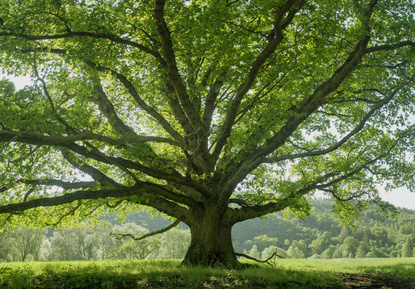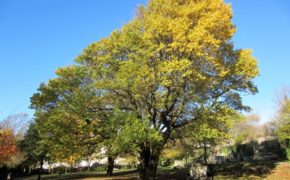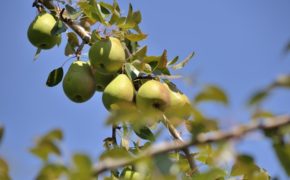
Get a quick no obligation quote It’s free and will only take a jiffy!
Oak Tree
Everything you need to know about the mighty English oak tree, from identification tips to typical characteristics; a step by step lifespan; how to prevent disease and the best methods of oak tree care.
The mighty English oak is feasibly the best known and most admired British native tree. It is certainly the most common tree species in the United Kingdom, particularly across the central and southern deciduous woodlands.
General Facts
| Known as | English oak, common oak |
| Latin name | Quercus robur |
| Location | UK, Europe, South West Asia |
| Foliage | Deciduous |
| Lifespan | 1,000 years+, average 150-250 years |
Characteristics
| Height | Average 20 metres but can grow up to 40-45 metres |
| Spread | At least 8 metres but the width can often grow to match the height |
| Appearance | Sprawling, twisted branches and rough, ridged bark |
| Leaves | Grow in bunches; display 5-6 deep lobes with smooth edges and very short stems. Bright green in spring, deep green summer to early autumn turning to yellow, golden then deep rust coloured in autumn. |
| Flowers | Long-hanging yellow pollen-producing catkins |
| Fruit | Acorns appear in summer growing from long stalks held tightly by a cup-shaped base, transitioning from green to brown before falling to the ground in early autumn to either take root and germinate or provide food for wild animals and birds. |
Conditions
| Ideal soil | Chalk, clay, loam, sand – oaks are lime tolerant and prefer fertile, deep soil that is moist but well-drained |
| Soil pH | Alkaline, neutral, acid |
| Aspect | North, south, east or west facing |
| Exposure | Full sun or partial shade |
Threats
| Pests | Oak gall wasps, leaf-mining moths, caterpillars, aphids |
| Diseases | Oak Decline including Acute Oak Decline and Chronic Oak Decline; powdery mildew |
How to Identify the English Oak Tree Through the Seasons
Spring: Bright green leaves begin to emerge in late April together with yellow hanging catkin-style flowers. The distinctive twisting limbs can still be seen through the new leaf growth.
Summer: A full canopy of rich green leaves forms a majestic portrait. The canopy is at its fullest and small clusters of acorns are starting to appear.
Autumn: Leaves start turning yellow in early autumn as the acorns fall to the ground. Gradually the leaves transform through a mini kaleidoscope of colour, from yellow to golden, rust to dark rust and finally, golden brown.
Winter: The leaves have finished falling and the branches are bare. It can be tricky at this time of year to identify a tree generally; however the oak gives it away with its expansive, weighty branches that wind and coil and its knobbly ridged, rough bark.
The Lifespan of an Oak Tree
Acorn: The oak tree starts life as an acorn. Each acorn carries a single seed and when that germinates, a taproot is produced. This taproot will act as an anchor for the tree, and will stay with the tree throughout its life.
Seedling: In the spring, the seed produces a shoot which will go on to grow leaves to pull in energy from the sun to support growth.
Sapling: Once the seedling has been growing for a year or so it becomes a sapling which will continue growing, providing it does not become food for passing herbivorous wildlife and that it gets enough sunlight and water.
Young tree: During the first 100 years of its life, an oak tree is considered young. It will start to produce a full crop of acorns at around the age of 40-50 years, by which time it will usually have reached its ultimate height, although it will continue to grow into adulthood.
Adult: By 100 years old the oak tree will reach adulthood and will be producing large crops of acorns, achieving peak production at around 80-120 years at which point its growth starts to gradually decline. During its lifetime, an oak tree will produce in the region of 10 million acorns which have the potential to grow into a new generation of oak trees. An adult oak tree will continue to grow to around 45 metres in height.
Old Age: After 700 years the oak tree has reached old age and will be producing few acorns and growing at a much reduced rate. By 1,000 years of age the tree will start to die.
Oak Trees and Wildlife
The English oak is of key importance to the UK’s wildlife, supporting more life forms than any other tree native to the United Kingdom. British birds enjoy the rich supply of hundreds of species of insect and the shed acorns provide important sustenance for the likes of badgers and deer.
Once the fallen leaves of the oak tree start to decompose, they form a rich mould that supports a range of insects and beetles. Birds find refuge in the nooks and crannies of the oak tree’s bark, whilst numerous species of British bat will roost under loose bark or in holes made by woodpeckers whilst enjoying a feast on the generous supply of insects which have made their home in the expansive canopy.
Oak Tree Symbolism
Thanks to its long lifespan, the oak tree has for hundreds of years been considered a national symbol of strength and survival and has over the years played an important role in English culture. The Christmas Yule Log was traditionally cut from the oak tree; ancient kings would adorn themselves with oak leaf crowns and a host of organisations worldwide use the oak leaf as a key emblem denoting environmental harmony, including the likes of the Woodland Trust.
Caring for an Oak Tree
Oak trees benefit from regular pruning during their younger years. Young oaks will develop a strong central leading branch when regularly pruned, and will usually experience a growth burst after pruning, providing it is done at the right time. Formative pruning is a specialist process which should only be carried out by experts who are trained to understand the biology of the tree and how it should be cared for at the various stages of its early growth.
Mature oak trees should be regularly pruned to remove dead wood and broken branches. This again is a specialist job requiring experience in working at height and of using fit-for-purpose cutting tools capable of dealing with the thick, expansive branches typical of an oak tree.
It is important to bear in mind that pruning slows growth whilst instigating bud development, vital for the healthy development of the tree. If entire limbs are removed for any reason other than being dead or diseased and therefore posing a risk, the tree could suffer damage due to its interior being exposed to the sun: another reason why specialist attention is vital.
Furthermore, due to the risk of Oak Decline, it is vital that oak tree pruning is carried out at the right time of the year. Again a qualified, experience expert tree surgeon will be able to advise on this. Further information on pruning an oak tree.
If you have an oak tree on your land that needs expert tree care, why not talk to T.H. Tree Services? As fully qualified and highly experienced tree surgeons, we are able to offer extensive knowhow on all aspects of oak tree care. For a free, no-obligation quotation, give us a call on 01268 642814 or get in touch here.
Had a fallen tree in the early hours of Monday morning, called for quote and the team had it cleared on the same day. Really good communication when the lads were onsite and did a great job. Lots of pride in their work shown with the thorough clear up. Would thoroughly recommend.
Thank you Stuart for your kind review. We were glad to be able to help you with your fallen tree. If there's anything else you need in the future, please don't hesitate to get in touch.








